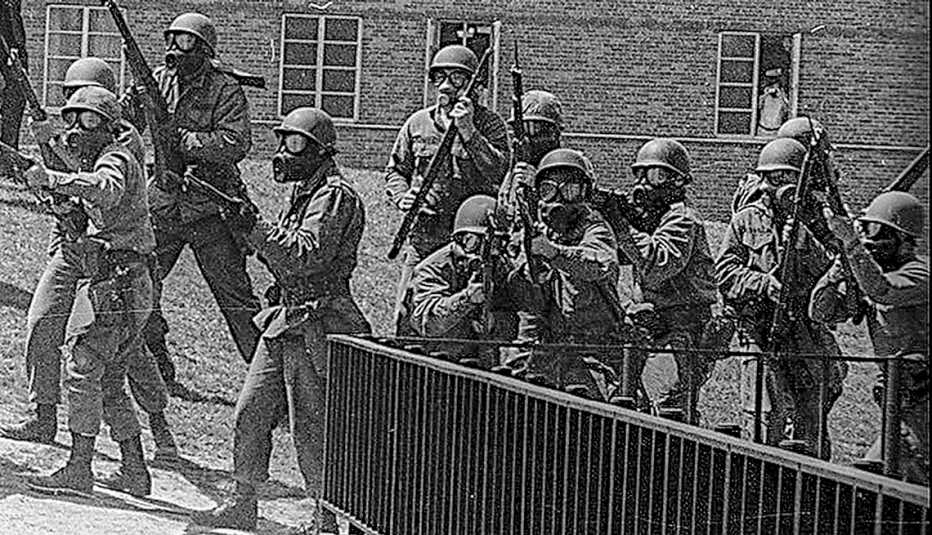AARP Hearing Center
America was in a state of unrest in the spring of 1970. The invasion of Cambodia by American-backed South Vietnamese forces appeared to be an expansion of an increasingly unpopular war in Southeast Asia. Student protests, already widespread, swelled in number and intensity on the nation's college campuses.
Kent State University, in northeastern Ohio, was no exception. Protesters burned an ROTC building over the first weekend in May. The Ohio National Guard was sent to the campus.
But even against the backdrop of increasing violence, no one was prepared for the news that rocked America on Monday, May 4: Four young people had been killed by gunfire from National Guard troops at Kent State.
The deaths would deepen the anger toward the war and further divide America. A photo by student journalist John Filo, of a young woman kneeling over the body of a student, became an indelible image of the era.


Eight guardsmen would be indicted by an Ohio grand jury. They claimed self-defense. All charges were eventually dropped. No one was ever convicted of the shootings.
But that afternoon, all anyone who was there knew was that something unthinkable and tragic had happened. Here are some accounts of eye witnesses.
John Filo
A 21-year-old journalism student then, Filo snapped the iconic photograph of a slain youth at Kent State and won a Pulitzer Prize. The photo became the lasting symbol of the tragedy. Today he lives in Hightstown, New Jersey.
I went outside with my camera and six rolls of film. Thousands of students wanted to see what was going on, and I did, too. I went to where the guardsmen were. It looked like a battlefield with the burned-down ROTC building. A jeep rolled in with law enforcement. The National Guard announced this was an illegal gathering. Boos and jeers followed.
The National Guard regrouped toward Taylor Hall and left my vision. I walked down the sidewalk and, all of a sudden, the guard reappeared. They're shooting at me! I thought it was a new scare tactic. I thought, This is crazy. These blanks are going to put out someone's eyes. I wanted to get a picture of them firing, but a guardsman was pointing his rifle at me. I heard the bullet go by my head, whizzing like a bee. It hit a metal sculpture, knocking off rust, then hit a tree, with a chunk of bark coming off. God, someone's using live ammunition, I thought.
I saw a body on the asphalt. There was so much blood, I couldn't believe it. My initial reaction was: Am I shot and don't know it? I walked to the dead person. I shot my picture. Then I saw this young girl run up — Mary Ann Vecchio. I knew I was running out of film. I already had the best picture I ever shot. I needed time to change film, but I didn't have time. Mary Ann knelt next to a body.
I didn't shoot right away because it might have been my last available frame. Mary Ann screamed. I shot the picture, then two more.
I immediately reloaded my camera. Back then, being a photographer was not popular. Some thought you were working for a secret agency. The police didn't want you shooting their actions. I had students screaming at me, “What kind of pig are you?''
I stayed until the wounded were removed. It seemed like forever. What happened next was more bizarre. Initial radio reports said two guardsmen and two students were killed. A few hundred students sat and looked at the National Guard. They said that if the students didn't disband, they were going to shoot again. No one moved. It was the most afraid I've ever been. Professor [Glenn] Frank was in tears. He said, “These people are crazy. You must get out of here.'’
The mayhem was over. Finally.


Twenty-five years later, I finally met Mary Ann. We both cried. She realized that I had to do what I had to do as a photojournalist. She was 14 and a runaway at the time of the killings. She reacted differently that day. Decades later, it dawned on me why. It was her youth. Others kept their distance — she convulsed. She wanted to save this person.
I am the luckiest person on earth. After winning the Pulitzer Prize at 21, I was thinking that I was a pretty damn hotshot photographer. A couple of days later, I got a call from the AP photo editor, who was my hero. He said, “Congratulations. Let's see what you can get tomorrow.''
Tom Grace
Grace was a 20-year-old student on the day of the shootings. He was wounded in the left foot by a gunshot. Today he lives in Buffalo, New York.
There had been a lot of discussion at school about our country's recent invasion of Cambodia, and what had happened on campus in previous days. More than 1,000 National Guardsmen were on campus and in town. I promised my girlfriend that I would not go to the rally. My father had been in the National Guard. I chose to go to the Commons for the protest. I thought, What harm could there be? In retrospect, it was very naive.


On campus, we saw the National Guard in a skirmish line. They ordered us to disperse. It only seemed to rile up students more. Some were veterans. The National Guard launched tear gas canisters into the crowd. Some students defiantly remained. I fled up the hillside. I had been (slightly) effected by the tear gas. By the time I got to Prentice Hall, girls moistened paper towels for us. I helped students overcome by tear gas.


































































